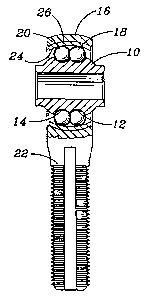Une partie des informations de ce site Web a été fournie par des sources externes. Le gouvernement du Canada n'assume aucune responsabilité concernant la précision, l'actualité ou la fiabilité des informations fournies par les sources externes. Les utilisateurs qui désirent employer cette information devraient consulter directement la source des informations. Le contenu fourni par les sources externes n'est pas assujetti aux exigences sur les langues officielles, la protection des renseignements personnels et l'accessibilité.
L'apparition de différences dans le texte et l'image des Revendications et de l'Abrégé dépend du moment auquel le document est publié. Les textes des Revendications et de l'Abrégé sont affichés :
| (12) Brevet: | (11) CA 2152990 |
|---|---|
| (54) Titre français: | EMBOUT A ROTULE DESTINE AUX AERONEFS |
| (54) Titre anglais: | ROD END BEARING FOR AIRCRAFT USE |
| Statut: | Durée expirée - au-delà du délai suivant l'octroi |
| (51) Classification internationale des brevets (CIB): |
|
|---|---|
| (72) Inventeurs : |
|
| (73) Titulaires : |
|
| (71) Demandeurs : |
|
| (74) Agent: | NORTON ROSE FULBRIGHT CANADA LLP/S.E.N.C.R.L., S.R.L. |
| (74) Co-agent: | |
| (45) Délivré: | 2005-11-01 |
| (22) Date de dépôt: | 1995-06-29 |
| (41) Mise à la disponibilité du public: | 1996-06-17 |
| Requête d'examen: | 2002-06-26 |
| Licence disponible: | S.O. |
| Cédé au domaine public: | S.O. |
| (25) Langue des documents déposés: | Anglais |
| Traité de coopération en matière de brevets (PCT): | Non |
|---|
| (30) Données de priorité de la demande: | ||||||
|---|---|---|---|---|---|---|
|
Une bague de roulement à billes située sur la surface interne de la bague externe d'un embout à rotule conçu pour être utilisé sur des aéronefs est durcie par un procédé de nitruration tout en laissant le reste de la bague souple et ductile pour résister à la rupture.
The ball raceways on the inside surface of the outer ring of a rod end bearing to be used on aircraft is hardened by a nitriding process while at the same time leaving the remainder of the ring soft and ductile to resist fracture.
Note : Les revendications sont présentées dans la langue officielle dans laquelle elles ont été soumises.
Note : Les descriptions sont présentées dans la langue officielle dans laquelle elles ont été soumises.

2024-08-01 : Dans le cadre de la transition vers les Brevets de nouvelle génération (BNG), la base de données sur les brevets canadiens (BDBC) contient désormais un Historique d'événement plus détaillé, qui reproduit le Journal des événements de notre nouvelle solution interne.
Veuillez noter que les événements débutant par « Inactive : » se réfèrent à des événements qui ne sont plus utilisés dans notre nouvelle solution interne.
Pour une meilleure compréhension de l'état de la demande ou brevet qui figure sur cette page, la rubrique Mise en garde , et les descriptions de Brevet , Historique d'événement , Taxes périodiques et Historique des paiements devraient être consultées.
| Description | Date |
|---|---|
| Inactive : Périmé (brevet - nouvelle loi) | 2015-06-29 |
| Inactive : TME en retard traitée | 2008-08-13 |
| Lettre envoyée | 2008-06-30 |
| Inactive : CIB de MCD | 2006-03-11 |
| Inactive : CIB de MCD | 2006-03-11 |
| Inactive : CIB de MCD | 2006-03-11 |
| Inactive : CIB de MCD | 2006-03-11 |
| Accordé par délivrance | 2005-11-01 |
| Inactive : Page couverture publiée | 2005-10-31 |
| Lettre envoyée | 2005-08-25 |
| Inactive : Taxe finale reçue | 2005-08-02 |
| Taxe finale payée et demande rétablie | 2005-08-02 |
| Réputée abandonnée - omission de répondre à un avis sur les taxes pour le maintien en état | 2005-06-29 |
| Lettre envoyée | 2005-02-10 |
| Un avis d'acceptation est envoyé | 2005-02-10 |
| Un avis d'acceptation est envoyé | 2005-02-10 |
| Inactive : Approuvée aux fins d'acceptation (AFA) | 2005-02-01 |
| Modification reçue - modification volontaire | 2003-02-04 |
| Lettre envoyée | 2002-07-26 |
| Inactive : Dem. traitée sur TS dès date d'ent. journal | 2002-07-26 |
| Inactive : Renseign. sur l'état - Complets dès date d'ent. journ. | 2002-07-26 |
| Exigences pour une requête d'examen - jugée conforme | 2002-06-26 |
| Toutes les exigences pour l'examen - jugée conforme | 2002-06-26 |
| Demande publiée (accessible au public) | 1996-06-17 |
| Date d'abandonnement | Raison | Date de rétablissement |
|---|---|---|
| 2005-06-29 |
Le dernier paiement a été reçu le 2005-08-02
Avis : Si le paiement en totalité n'a pas été reçu au plus tard à la date indiquée, une taxe supplémentaire peut être imposée, soit une des taxes suivantes :
Veuillez vous référer à la page web des taxes sur les brevets de l'OPIC pour voir tous les montants actuels des taxes.
Les titulaires actuels et antérieures au dossier sont affichés en ordre alphabétique.
| Titulaires actuels au dossier |
|---|
| THE TORRINGTON COMPANY |
| THE TORRINGTON COMPANY |
| Titulaires antérieures au dossier |
|---|
| MICHAEL M. DEZZANI |
| PHILIP K. PEARSON |